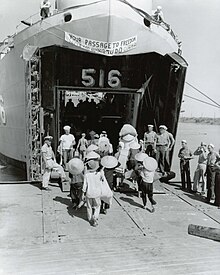This article needs additional citations for verification. (February 2021) |
Bắc 54, or Bắc Kỳ 54 (both meaning "Northern [Vietnamese of] 1954"), refers to Northern Vietnamese people living in (or from) southern Vietnam, who migrated there from North Vietnam in 1954 and early 1955, mostly through Operation Passage to Freedom.


Operation Passage to Freedom
editOperation Passage to Freedom was an initiative by the U.S. Navy and French military to transport Vietnamese civilians who wished to relocate to the Southern half of Vietnam from the North, mostly by ship or aircraft, as provided under the 1954 Geneva Accords, which created a 300-day period where people could migrate freely between communist North Vietnam and anti-communist South Vietnam before the border was sealed on May 18, 1955. Bắc 54 who fled South through Passage to Freedom number variously from 810,000[1] to almost 1 million[2] (in 1955). An additional 109,000 fled south by their own means, some arriving outside the 300-day period (e.g. after the Quỳnh Lưu Uprising). The people who fled on their own did so by trekking through Laos, boarding local fishing vessels after payment on spot, or journey overland if they were in Quảng Bình. The migrants were mainly political refugees who were escaping the impending rule of the North Vietnamese communist government, headed by Ho Chi Minh, that was to officially rule the entire Northern halve in 1955, and to escape potential persecution by the new regime. However, there were also other reasons for why they left. Many Northern Catholics were among the migrants, forming around one-third of the refugees (~300,000). The vast majority originated from the Red River Delta region, particularly Hanoi, Hải Phòng, Ninh Bình, and Nam Định; few of the emigres came from the provinces of the rural North-Central provinces of Thanh Hoá, Nghệ An, Hà Tĩnh and Quảng Bình, and even fewer came from the landlocked mountainous provinces of far Northwest and Northeast Vietnam. The reason for this is because the Viet Minh sought to detain or prevent refugees from leaving, by trying to stop people through a military presence in the rural side and inland areas or terminating ferries in the Red River Delta, interdicting the flow of would-be refugees, many of whom were aiming to reach ships and ferries in Hải Phòng or Hà Nội, as the American and French military personnel engaged in the refugee operation were only present in the major cities, air bases and on the waterfront.[1] The communists were most effective in Nghệ An and Thanh Hóa Provinces, which they had long controlled.[3]
Locations
editMany of the Bắc 54 later settled in the coastal provinces of Bà Rịa–Vũng Tàu and Bình Thuận (where many continued fishing as they did in the North), Đồng Nai Province (where many continued in agriculture), or in the cities of Saigon and Biên Hòa. Biên Hòa would later be the site of a small-scale resistance to the new Communist government in the months immediately following the fall of South Vietnam in 1975, because of its high concentration of anti-communist former refugees and their descendants who had fled the Communist government of North Vietnam in 1954-1955.
References
edit- ^ a b Frankum, Ronald (2007). Operation Passage to Freedom: The United States Navy in Vietnam, 1954–55. Lubbock, Texas: Texas Tech University Press. pp. 14, 159–160. ISBN 978-0-89672-608-6.
- ^ Lindholm, Richard (1959). Viet-nam, The First Five Years: An International Symposium. Michigan State University Press. p. 49. ISBN 1258173123.
- ^ Hansen, Peter (2009). "Bắc Di Cư: Catholic Refugees from the North of Vietnam, and Their Role in the Southern Republic, 1954–1959". Journal of Vietnamese Studies. 4 (3). Berkeley, California: University of California Press: 188. doi:10.1525/vs.2009.4.3.173.